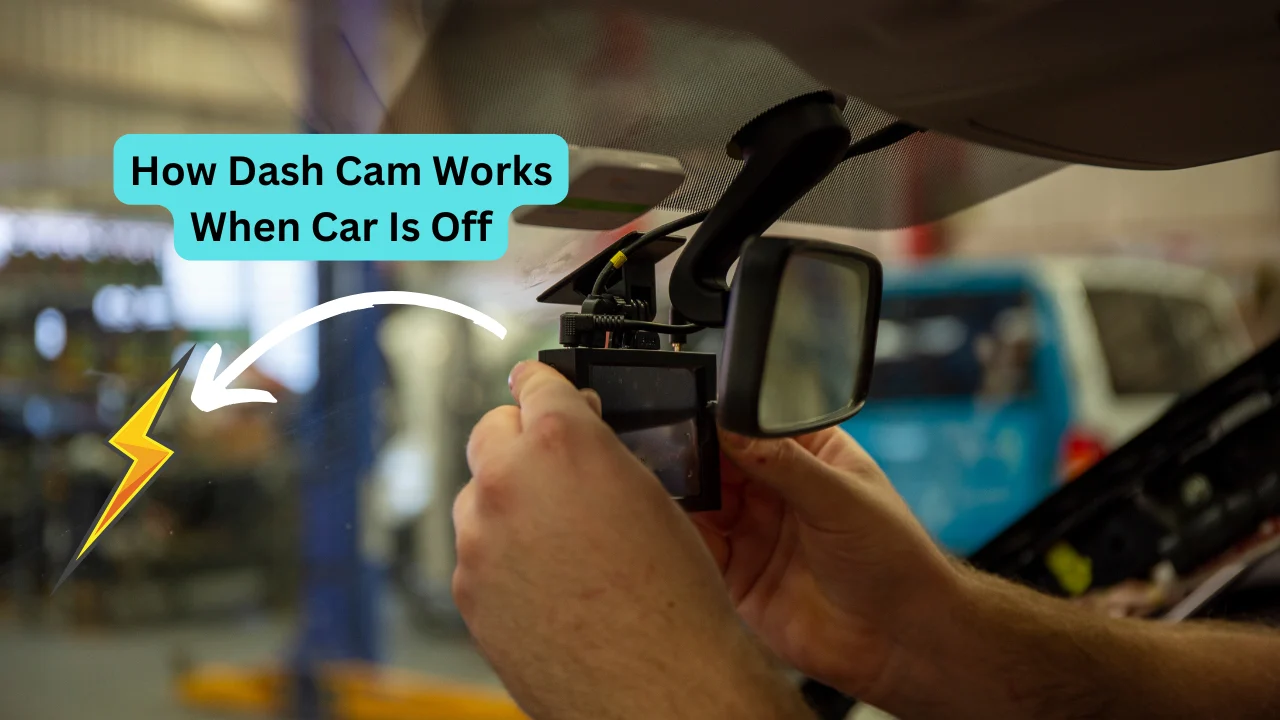Have you ever wondered how does dash cam work when car is off? It’s a great question, especially if you’re considering enhancing your vehicle’s security. Dash cams typically operate when the car is running, but modern ones come with a “parking mode” that keeps them working even when the car is off. For a complete guide on installing a dash cam wire in your car, refer to our article How to Install Dash Cam Wire in Car.
With over 60% of dash cam owners finding parking mode essential, it’s a valuable feature for added protection. Whether you’re worried about vandalism or simply want to capture any unusual activity, parking mode ensures your car remains monitored when you’re away. It’s like having an extra set of eyes, even when you’re not around.
Quick Look
A dash cam works when the car is off by using parking mode, which detects motion or impacts. It stays powered through an external source, like a hardwired connection or a dedicated battery. This lets it record while the car is parked without draining the main battery.
How can I ensure my dash cam doesn’t drain my car battery?
To ensure your dash cam doesn’t drain your car battery, consider a few key steps. First, choose a dash cam with low power consumption, typically around 0.2 to 0.5 amps. Installing a voltage cutoff feature is also a smart move, as it automatically shuts off the dash cam when the car’s battery voltage drops below a safe level, usually around 11.8 volts.
Proper hardwiring to your car’s fuse box can provide a stable power source without draining the main battery. Alternatively, using a dedicated battery pack designed for dash cams when the car is off is another effective solution.
What Is Parking Mode?

When I first heard about parking mode on dash cams, I was curious how they could work when the car is off. It’s a great feature that allows the dash cam to keep an eye on your vehicle even when you’re not around.
Parking mode is designed to make sure your car remains monitored when parked. It captures footage of incidents like collisions, vandalism, or theft, especially when you’re away. With this feature, you can feel a lot more secure leaving your car unattended.
Why Is Parking Mode Important?
I’ve found that parking mode is a real game-changer for protecting your vehicle. It’s especially helpful in situations where the car is hit while parked or if someone scratches your vehicle. Around 1 in 5 people experience some form of parking lot damage each year, so having footage from a dash cam could be a lifesaver.
How Parking Mode Protects Your Car
What makes parking mode stand out is its ability to activate automatically when something happens around your car. Whether it’s someone bumping into your car or a car speeding by, the dash cam is on standby, ready to record. It can give you clear footage of the incident, which might help with insurance claims or police reports.
When Do Dash Cams Use Parking Mode?
A dash cam with parking mode doesn’t need your car to be running to start recording. In fact, it can remain in low-power mode when your vehicle is off and will only kick into action when something triggers it. With this feature, you don’t need to worry about missing any action while you’re away. Need help inflating a bicycle tire? Get all the steps in our guide How to Inflate Bicycle Tire.
How Does Parking Mode Work?

When the car is off, how does a dash cam stay active and useful? Well, dash cams use a couple of clever methods to ensure they keep recording even when you’re not around.
Motion Detection
Dash cams equipped with parking mode can detect movement around the vehicle. For instance, if someone walks past your car or another vehicle comes too close, the dash cam automatically starts recording. This feature can capture incidents like someone backing into your parked car, which is great for security.
Impact Detection
Dash cams also come with built-in G-sensors that can detect sudden impacts. If another car bumps into yours or someone hits your vehicle, the G-sensor triggers the camera to start recording immediately. Some cameras can even save the footage to a secure file so you don’t lose evidence, even if the event happened hours ago.
If your car won’t jump-start but the lights come on, check out our detailed guide Car Won’t Jump Start But Lights Come On.
Powering the Dash Cam When the Car Is Off

When your car is off, you still need a way to keep your dash cam running, especially if you’re relying on parking mode. There are a few methods that help you achieve this, and each comes with its own benefits.
Hardwiring to the Vehicle’s Electrical System
The most common method is hardwiring your dash cam to your car’s electrical system. This involves connecting the cam directly to the car’s fuse box or battery. In fact, most professional dash cam installations recommend this for continuous power, ensuring your camera is always ready to record, even when you’re not around.
Using a Battery Pack for Power
Another way is by using an external battery pack. These packs can store power while you’re driving and then supply it to the dash cam when the car is off. Some battery packs can run a dash cam for up to 24 hours without draining your car’s battery, making this an excellent option if you want to avoid any battery concerns.
OBD-II Port Power Supply
Some dash cams can tap into your car’s OBD-II port for power. This method is easy to set up and doesn’t require significant alterations to your car’s electrical system. However, it’s important to note that not all vehicles support this, so you’ll need to check if your car is compatible before opting for this solution. You can find out more about EV jump starters in our article EV Instant Power Jump Starter.
Considerations for Using Dash Cams in Parking Mode
When using a dash cam in parking mode, it’s important to consider a few factors to ensure that it works effectively without draining your car’s battery or violating any laws. Let’s dive into the key things to keep in mind.
Battery Drain
One of the main concerns with using a dash cam when the car is off is the potential for battery drain. Dash cams consume power even when you’re not driving, and without the car’s engine running, it’s easy to deplete your car battery.
For example, some dash cams can draw up to 300mA in parking mode, which may not seem like much, but over several days, it can add up. Many newer dash cams come with voltage monitoring to prevent this, cutting off power when the battery drops to around 11.8V.
Storage Management
Another consideration is managing the dash cam’s storage. Dash cams typically record in loops, where older footage is overwritten by new recordings. For instance, a 32GB microSD card can store roughly 5-6 hours of high-definition footage before it begins to loop.
If you’re relying on parking mode for multiple days, it’s a good idea to use a larger SD card or choose a dash cam with built-in time-lapse recording, which reduces file sizes.
Legal Compliance
Before installing your dash cam, it’s essential to understand the legal landscape. Depending on where you live, there could be restrictions on video and audio recording without consent.
In the U.S., for example, it’s legal to record video in public places, but some states require consent for audio recordings. It’s always a good idea to check your local laws or consult with a professional to ensure that you’re complying with privacy regulations. Learn all about the 4-in-1 jump starter with an air compressor by reading our article 4-in-1 Jump Starter with Air Compressor.
Wrap Up
When asking how does dash cam work when car is off, I’ve found it’s crucial for vehicle security. Dash cams with parking mode can monitor the vehicle even when it’s parked, recording any unusual activity.
With features like motion and impact detection, it ensures you’re always covered. However, remember to monitor power usage to avoid draining your car’s battery—dash cams typically consume 0.2 to 0.5 amps. This technology offers peace of mind for anyone looking to protect their vehicle.
FAQs
How does parking mode work in a dash cam when the car is off?
Parking mode allows the dash cam to continue recording when the car is off. It uses sensors like motion detection or impact detection to start recording events like hits, bumps, or movements around the vehicle.
The dash cam stays powered through an external power source, typically a hardwiring kit connected to the car’s battery or an auxiliary battery pack. This way, the dash cam can monitor your vehicle even when you’re not around, without draining your main car battery.
Can a dash cam record when the car is parked for a long period of time?
Yes, a dash cam can record while the car is parked for a long time, especially if it’s equipped with parking mode. However, the duration it can record depends on the power source.
If it’s hardwired to the car’s electrical system or uses a dedicated battery pack, the dash cam can run for hours or days, depending on the setup. It’s important to ensure that your power supply doesn’t drain the car battery, as some models feature voltage cutoff settings to prevent that.
Will using a dash cam in parking mode drain my car’s battery?
Using a dash cam in parking mode can drain your car’s battery if not properly set up. Dash cams in parking mode use a small amount of power, but without a proper voltage cutoff feature, they may draw from the car’s main battery.
To prevent this, install a dash cam with a voltage cutoff feature, which ensures it turns off when the battery level drops below a safe threshold, usually around 11.8 volts. Alternatively, using a dedicated battery pack can also help avoid draining your car battery.
What’s the best way to power a dash cam when the car is off?
The best way to power a dash cam when the car is off is by hardwiring it to the car’s electrical system or using a dedicated battery pack. Hardwiring connects the dash cam directly to the vehicle’s fuse box, providing a consistent power source.
Alternatively, a battery pack designed for dash cams allows the device to operate independently from the car’s main battery. Both options ensure the dash cam remains operational in parking mode without risking battery drain from the car’s primary power source.

